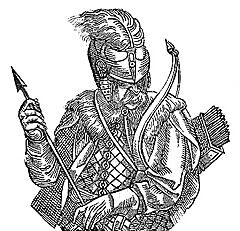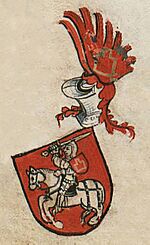Švitrigaila facts for kids
Quick facts for kids Švitrigaila |
|
|---|---|
|
|

Švitrigaila by Alexander Guagnini
|
|
| Grand Duke of Lithuania | |
| Reign | October 1430 – 31 August 1432 |
| Predecessor | Vytautas |
| Successor | Sigismund Kęstutaitis |
| Grand Duke of Ruthenia | |
| Reign | 1432–1440 |
| Predecessor | Vytautas |
| Successor | Casimir IV |
| Prince of Volhynia | |
| Reign | 1434–1452 |
| Predecessor | Teodoras |
| Successor | Simonas |
| Born | Before 1370 |
| Died | 10 February 1452 |
| Spouse | Anna of Tver |
| Issue | Son (died young) |
| Dynasty | Gediminid |
| Father | Algirdas |
| Mother | Uliana of Tver |
| Religion | Roman Catholic prev. Lithuanian paganism |
Švitrigaila (born before 1370, died 1452) was a powerful leader in Lithuania. He was the Grand Duke of Lithuania from 1430 to 1432. Švitrigaila spent much of his life trying to gain power. He often struggled against his cousins, Vytautas and Sigismund Kęstutaitis.
Contents
Early Life and First Rebellions
Švitrigaila was born to Algirdas, who was also a Grand Duke of Lithuania. His mother was Uliana of Tver. He was likely one of Algirdas's youngest sons. Švitrigaila first appeared in history in 1382. He was a witness to an important agreement called the Treaty of Dubysa. This treaty was between his older brother Jogaila and the Teutonic Knights. Historians believe Švitrigaila was at least 12 years old then. This means he was born before 1370.
In 1386, Švitrigaila became a Roman Catholic. This happened as part of the Christianization of Lithuania. It was also part of the Union of Krewo, which joined Poland and Lithuania. He was baptized in Kraków and given the name Bolesław.
Švitrigaila became involved in politics around 1392. After his mother died, Jogaila put someone else in charge of Vitebsk. This made Švitrigaila angry, so he rebelled against his brother. Vytautas, who had just become Grand Duke, and Skirgaila gathered an army. They captured several cities, including Vitebsk. Švitrigaila was caught and sent to Kraków. He was not kept in a harsh prison. He even helped with border talks in 1393. However, he did not have his own lands at this time.
Struggles Against Vytautas (1392–1430)
Švitrigaila spent many years trying to gain more power. He often allied with Lithuania's enemies.
Seeking Help from Other Rulers
Around 1396 or 1397, Švitrigaila escaped from Kraków. He went to the court of Sigismund of Luxemburg, who was King of Hungary. Švitrigaila then contacted the Teutonic Knights. These Knights were long-time enemies of Lithuania. He suggested they form an alliance against Vytautas. Vytautas himself had done similar things in the past. However, the Knights made a peace treaty with Vytautas in 1398. This left Švitrigaila without support for a rebellion.
Švitrigaila then made peace with Vytautas. He was given control of Navahrudak and parts of Podolia. In 1399, Švitrigaila survived a terrible battle against the Golden Horde.
Joining the Teutonic Knights
In 1401, Vytautas and Lithuanian nobles signed an agreement. It stated that after Vytautas died, Jogaila or his heirs would rule Lithuania. This agreement crushed Švitrigaila's hopes of becoming Grand Duke. Some historians believe this agreement was made to control Švitrigaila's growing power.
In 1402, Švitrigaila secretly went to Marienburg, the capital of the Teutonic Knights. He signed a treaty with them. In July 1402, the Knights and Švitrigaila invaded Lithuania. They marched towards Vilnius, the capital. But Vytautas found out about their plan. The Knights did not attack Vilnius and went back to their lands. Peace talks began in 1403. In 1404, a peace treaty was signed. Švitrigaila received lands in Podolia, Zhydachiv, and other areas from Jogaila and Vytautas.
Alliance with Moscow and Imprisonment
For a few years, Švitrigaila was loyal to Vytautas. He helped with battles and talks. But his new lands were near the Grand Duchy of Moscow. This powerful state was becoming a rival to Lithuania. Švitrigaila decided to rebel against Vytautas again. This time, he sought help from Vasily I of Moscow. Vasily I was also Vytautas's son-in-law.
In May 1409, Švitrigaila and many other nobles joined Moscow. Vasily I gave Švitrigaila several towns. Vytautas quickly gathered an army and marched towards Russia. The two armies met at the Ugra River (Oka) but did not fight. A peace agreement was made. The Ugra River became the border between Russia and Lithuania.
It is not fully clear what happened to Švitrigaila next. Some reports say Vytautas demanded he be handed over. But in June 1409, Švitrigaila was back at Vytautas's court. He tried to secretly work with the Teutonic Knights again. His letters were found. Švitrigaila was arrested and imprisoned for nine years. He was held in different places, including Kremenets Castle.
Escape and Reconciliation
Švitrigaila escaped from prison in 1418. His escape was planned by several nobles. They attacked Kremenets Castle with 500 men. They freed Švitrigaila and captured Lutsk. Švitrigaila received support from local nobles. However, he chose to retreat to Wallachia. For a while, he lived with powerful rulers like Sigismund, Holy Roman Emperor.
At the same time, a rebellion started in Samogitia. The Teutonic Knights wanted to use this against Lithuania. They invited Švitrigaila to overthrow Vytautas. But instead, Švitrigaila made peace with Jogaila in 1419. Švitrigaila received lands and money. However, he was still not fully reconciled with Vytautas.
Polish nobles understood that Švitrigaila could cause trouble. They convinced Vytautas to forgive his cousin. In August 1420, an official agreement was made. Švitrigaila promised to be loyal. He received control of several important principalities.
After this, Švitrigaila became an active part of state politics. He won a battle against the Tatars in 1421. He took part in the Gollub War in 1422. He also went on a diplomatic mission to Riga and joined a raid against Novgorod.
Struggle Against Sigismund
Becoming Grand Duke
When Vytautas died in October 1430, Lithuanian nobles chose Švitrigaila as the new Grand Duke. This decision went against an earlier agreement with Poland from 1413. That agreement said Lithuanians needed Poland's approval to choose a new Grand Duke.
To gain support, Švitrigaila gave equal rights to Catholic and Orthodox nobles. This was an important achievement of his short rule. Polish nobles were very angry. They demanded that Švitrigaila recognize his brother Jogaila, the King of Poland, as his overlord. Švitrigaila refused. He declared Lithuania's full independence.
The conflict became more complicated due to land disputes. Švitrigaila fought against Polish-Lithuanian forces in Volhynia. At the same time, he started building a larger alliance against Poland. In June 1431, he made a deal with the Teutonic Knights. The Knights declared war on Poland. They invaded Poland while Polish forces were fighting Švitrigaila.
In September, a two-year truce was signed. It was more favorable to Poland. It is not clear why Švitrigaila agreed to it. The truce did not solve the main problems. The war then became a diplomatic struggle. Poland tried to turn Lithuanian nobles against Švitrigaila.
Coup and Civil War

On August 31, 1432, a group of plotters attacked Švitrigaila. They were led by Sigismund Kęstutaitis. Švitrigaila managed to escape to Polotsk. His pregnant wife, Anna of Tver, was captured. It is not fully known why Sigismund's supporters acted. Perhaps Lithuanian nobles were unhappy with Švitrigaila favoring Orthodox dukes.
Sigismund, who had not been a major political figure, became the new Grand Duke. He brought back the policy of union with Poland. Lithuania was then split into two sides. Sigismund's supporters were in the western lands. Švitrigaila's supporters were in the eastern lands, including Polotsk, Vitebsk, and Smolensk.
Three years of destructive fighting followed. Švitrigaila got help from Sayid Ahmad I, a leader of the Golden Horde. Both sides suffered many losses. Sigismund finally won a big victory in the Battle of Wiłkomierz in 1435. After this defeat, Švitrigaila fled to Polotsk. He lost his influence in the eastern lands.
In September 1437, Švitrigaila tried to make peace with Poland. He suggested he would rule the lands that still supported him. After his death, these lands would go to the King of Poland. However, the Polish Senate did not approve this treaty. Sigismund strongly protested it. Švitrigaila then retreated to Wallachia in 1438.
Later Years
In 1440, Sigismund Kęstutaitis was killed by nobles who supported Švitrigaila. Švitrigaila returned to rule Podolia and Volhynia. He was around 70 years old (some sources say 85). He was too old to fight for the Lithuanian throne again. Also, he did not have the support of the Council of Lords. This council chose Casimir Jagiellon as Grand Duke in June 1440. Casimir was the brother of Polish King Władysław III of Poland.
Švitrigaila died in Lutsk in 1452. Shortly before his death, he gave all his lands in Podolia and Volhynia to the Lithuanian state.

